The best varieties of remontant raspberries
Raspberry bushes delight not only with their appearance, but also with juicy, sweet fruits. The berries are used in cooking and folk medicine, they are boiled, frozen and dried. Some varieties are fast ripening, others - large-fruited and unpretentious in care. Among summer residents, special attention was paid to remontant varieties. What are their features and advantages, we will consider in the article.
The content of the article
Features of remontant varieties of raspberries
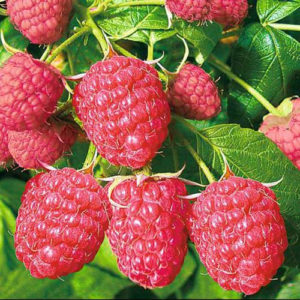
The crop is harvested from remontant raspberries several times per season: berries are formed on old and new shoots. Summer residents remove ripe fruits in July-August and early autumn, depending on the characteristics of the variety. Most remontant plants bear fruit for 60 to 80 days.
Such raspberry productive, but requires special care. It is impossible to get a good harvest without pruning the bushes and feeding. Plants are pruned annually after fruiting so that new shoots will grow until next summer.
Attention! Raspberry tutimer are remontant varieties suitable for double fruiting (from the English two timer - "two times"). These shrubs have a strong root system and increased vigor. Gardeners allocate raspberries Himbo Top, Zyugan, Brusvyan. Toothimers bear fruit in any region of Russia, guaranteeing a stable and high yield.
A remontant culture is planted only in a nutrient soil, into which twice as much fertilizer is previously applied as when planting conventional varieties. Chicken droppings are not suitable for feeding such plants: an excess of nitrogen in the soil will harm raspberries. It is better to use overripe compost or cow dung.
The best varieties of remontant raspberries
When choosing a variety, attention is paid to the ripening period, taste and marketability, and yield. For industrial cultivation, they choose high-yield plants with long shelf life, for making jam and compotes, sweet raspberries with pleasant pulp.
With a high yield
Many factors affect the yield of raspberries: soil condition and planting site, seedling preparation, climatic conditions, watering and fertilization. In order for the remontant variety to bear fruit stably, shoot pruning, measures to protect against diseases and pests are carried out.

Zeva
Description of the Zev raspberry variety: the bushes are medium-sized, the height is no more than 1.5 m. The shoots grow straight up, covered with rare thorns. It is advisable to install a trellis next to the plant: the support for the stems allows you to distribute the crop, prevents the bush from tilting to the side. The shape of the fruit is conical-round, the weight of one is from 2 to 5 g. The color is dark red, the flesh is firm and juicy. The taste is sweet and sour pleasant.
Raspberry Zeva is distinguished by its transportability and keeping quality, yield from 1 m2 - about 5 kg. Berries are good fresh, dried, frozen, and processed. Of the advantages of the variety, resistance to fungal and viral diseases, frost resistance are noted. Raspberries endure dry summers without loss of yield, form beautiful fruits.
Nugget
Mid-season remontant variety. Fruiting begins in mid-July and lasts until the first frost. The bushes are medium-sized, up to 2 m high. The foliage is dense, dark green. The length of the fruit branches is about 30 cm, from 15 to 20 berries are formed on one. The shape of the fruit is conical, weight - 10-15 g. The flesh is tender, the bones are small. The taste is sweet and sour.
When growing, the bush does not need to be tied, which makes it easier to care for the crop.Raspberry Nugget is famous for its large fruits and attractive commercial qualities. Berries are used for making pies and cakes, preserves and jams.
The sweetest and most delicious
The taste of raspberries depends on the characteristics of the variety and the applied fertilizers. For planting, choose spacious and sunny areas, protected from drafts. If you plant a seedling in a dark place, due to a lack of sun and heat, the berries will turn out sour.
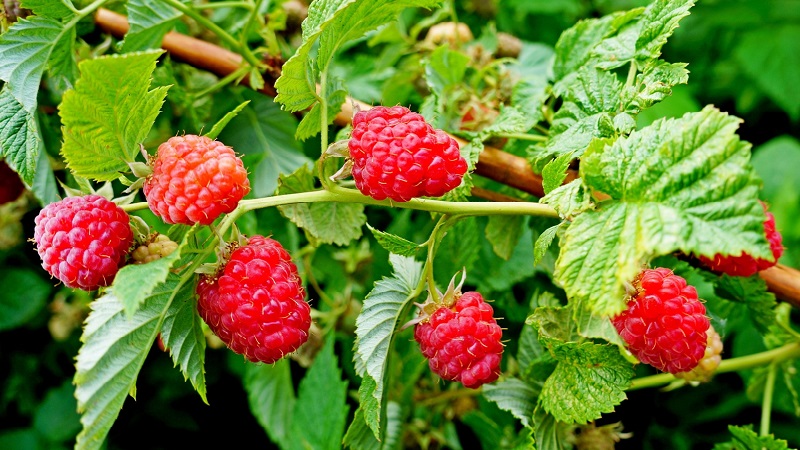
Aurora
A sweet and sugary Italian variety. The bushes are powerful and developed, the height is up to 2 m, they require a garter to the support. The leaves are large green. The berries are large, weight - about 5 g, transportable. The color is deep red. In use, the fruits are universal: they are used fresh and processed. The first crop is harvested at the beginning of July, the second at the end of August.
Aurora is planted in spring or autumn. In spring, the bush is tied to a support and pruning is carried out in 2 stages: shoots damaged by pests, weak and frozen branches are removed.
August miracle
An early ripe winter-hardy variety is grown in central Russia, in the Urals and Siberia. One bush gives up to 4 kg of raspberries annually.
Plants are erect, height - up to 2 m. The shoots are powerful, there are thorny thorns. The August miracle is tied to a support and cut off annually. The shape of the fruit is round-oval, the color is bright red. The berry weight is from 3 to 7 g, the taste is sweet with a pronounced raspberry aroma. The pulp is elastic and dense, does not crack, so the fruit is suitable for transportation. Repaired raspberries are rarely affected by diseases, they are universal in use.
Read also:
Raspberry varieties for the middle lane
Instructions for caring for raspberries in spring after winter and advice from experienced gardeners
Early
When growing early remontant raspberries, it is important to observe the feeding regime: thanks to fertilizers, the crop ripens on time and rarely gets sick. They introduce organic and mineral fertilizers, spray the bushes to protect them from diseases and pests. The first harvest of early ripe raspberries is harvested in July.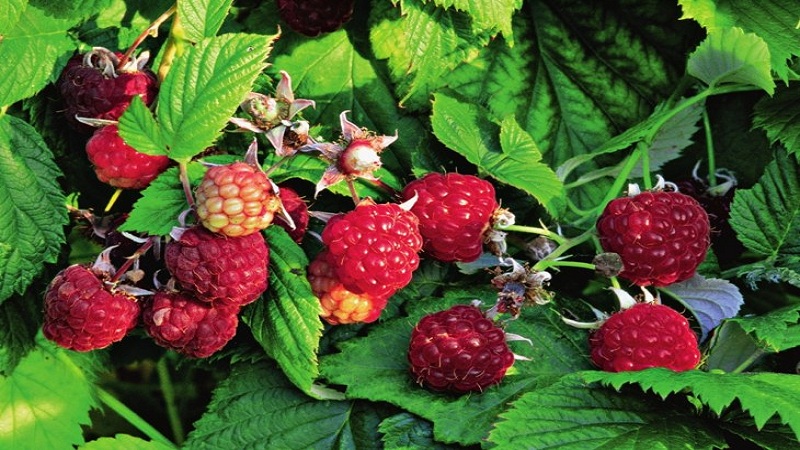
New
Repaired red raspberry variety. The bushes are powerful and spreading, the height is from 1.5 to 2 m. The shoots are upright and fast-growing, the leaves are juicy-green. Despite its size, the Novelty does not need a garter to the support.
The berries are large and sweet, weighing from 10 to 12 g. Sweet-sour pleasant taste. The pulp is medium density, delicate in taste. The novelty bears fruit stably, resistance to diseases and pests is average.
Attention! The main part of the roots of remontant raspberries is located in the upper layer of the soil - dry periods reduce the amount of harvest. The culture especially needs watering during the flowering period. For irrigation, use settled water at room temperature: cold water will provoke fungal or viral diseases.
In order for the bush to bear fruit early, it is covered with non-woven material for the winter. Under it, the green mass grows faster, which accelerates the development of fruits in summer.
Red Guard
Bushes are erect, shoots are located close to each other. The height of the plant is 1.5 m, so it is easy to take care of it; to harvest it, you do not need to stand on a support and reach the top. The Red Guard blooms in mid-June, after the 25th the first crop is harvested. Productivity - up to 9 kg per plant.
The berries are cone-shaped, weighing 12 g each, red-pink color. The taste is sweet with a bright berry aroma. The consistency of the pulp is tender, the density is medium. The Red Guard is frost-resistant. Fruits of the same size are used for sale and transportation, they are used fresh and processed.
Average
Mid-season raspberries ripen by the end of July, they are planted in the suburbs. It is unpretentious in care, the yield is stable. Most of the varieties are versatile and drought-resistant.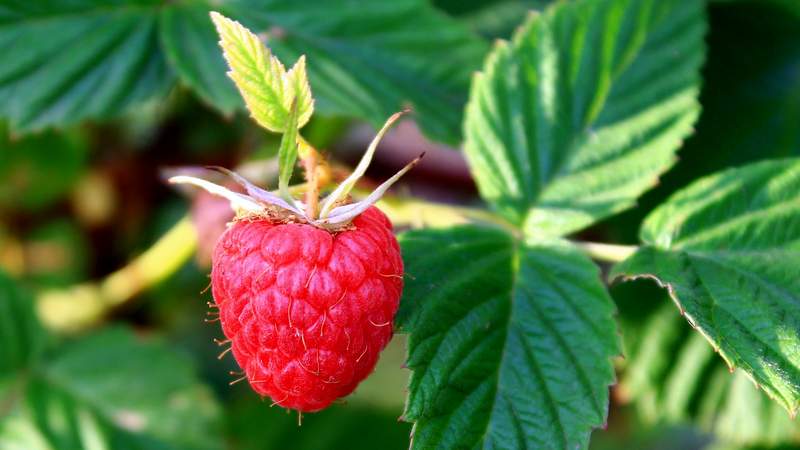
Handsome Sadko
Bushes are erect, erect, with a columnar crown. Height - up to 2 m, leaves are green, slightly wrinkled, average thorniness. Berries are round-conical large, weight of one - from 5 to 7 g.Dark crimson color, dessert pulp. The Krasavets Sadko variety is appreciated for the taste of berries: they are very sweet with a high sugar content.
Raspberries bear fruit from late July to early October. Productivity depends on the strength of the growth of the bush in the early years, so summer residents pay a lot of attention to mineral fertilizing.
Reliable
The Reliable raspberry got its name due to its stable yield, resistance to diseases and pests, unpretentious care. The bushes are medium-sized, the leaves are dark green, there are few thorns. The shape of the berries is conical with a blunt tip. Weight - from 5 to 7 g, dark crimson color. After ripening, the fruits hang on the bushes for 2 weeks, do not crumble, retain their marketability and taste. Sweet and sour dessert taste. Productivity - from 3 to 5 kg per bush, depending on weather conditions and soil.
Late
Late-ripening remontant varieties are grown in the Krasnodar Territory, Crimea and other warm and sunny regions. The crop is used to prepare winter preparations and is eaten fresh, and aromatic and healthy tea is brewed from the leaves.
Amber
Medium late variety for use. Bushes are powerful, slightly spreading. There are thin green thorns at the bottom of the stem. The fruits are round, weighing from 3 to 4 g, the surface is slightly ribbed with a waxy bloom. The color is original: in the sun Amber shimmers with an orange-golden hue.
The pulp is tender sweet and sour, no aroma. Tasting assessment of the variety - 3.8 points out of 5. Amber is resistant to drought and heat, rarely damaged by pests and diseases.
Polka
The reference variety Polka is popular throughout Europe. Plant height - up to 1.8 m, leaves are bright green, strong shoots. There are few thorns, so there will be no problems during harvest. Polka bears fruit for 3 months, yield - from 2 to 5 kg of berries per season. Fruit weight - 5–8 g, deep crimson color. The taste and aroma are sweet, the tasting score is 5 points out of 5.
The variety is distinguished by its transportability: during transportation, the berries do not crumple, retain an attractive appearance and great taste. Polka is rarely affected by spider mites and gray rot, and is unpretentious in care.
Reviews about the varieties of remontant raspberries
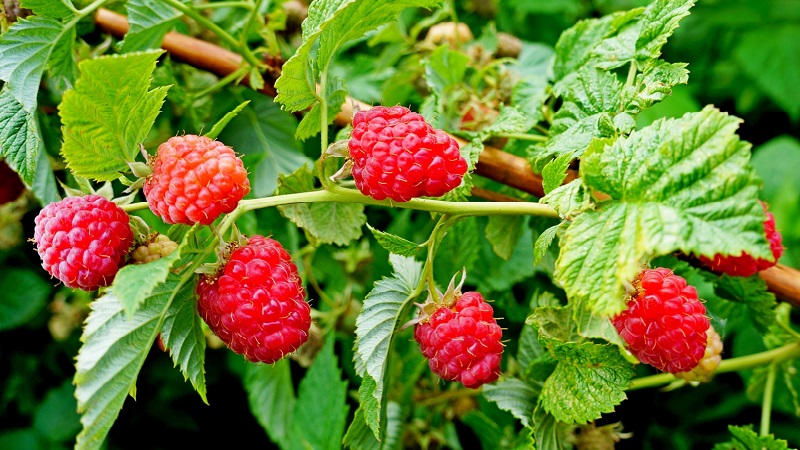
Reviews of summer residents about raspberry varieties will help you understand whether to plant a particular variety in the garden or choose a different crop.
Maria, Rostov region: “I plant only remontant varieties in the garden: they bear fruit longer, and berries give large and sweet. My favorite variety is Reliable. Raspberries do not get sick, the plants are compact, do not take up much space. I eat berries fresh or freeze for the winter. Their taste is juicy and bright, the flesh is pleasant. "
Vladimir, Leningrad region: "I prefer raspberries August miracle. The taste is excellent, the yield is stable. I fertilize with manure and do not forget to water, but the rest of the plant is unpretentious. I use it to make jam for the winter. But I didn’t like Yantarnaya: it’s beautiful, but the taste failed ”.
Vasilisa, Moscow: "My favorite remontant variety is Krasavets Sadko. The berries are juicy and sweet, we eat them with the whole family. Ripen amicably, do not fall off and do not crack. We add fresh raspberries to buns and pies - it turns out very tasty. "
Conclusion
Varieties Avgustovskoe Miracle and Aurora are distinguished by sweet and sugary pulp, rich berry aroma. They are good in any form and have attractive commercial qualities. Raspberry Zeva and Nugget are prized for their high and stable yield. For planting in the south, medium-late and late varieties are chosen: Polka or Amber, in the northern regions - Novinka and Red Guard.
When growing a remontant culture, it is important to observe agrotechnical rules: annually remove old and weak shoots, fertilize and water the soil.